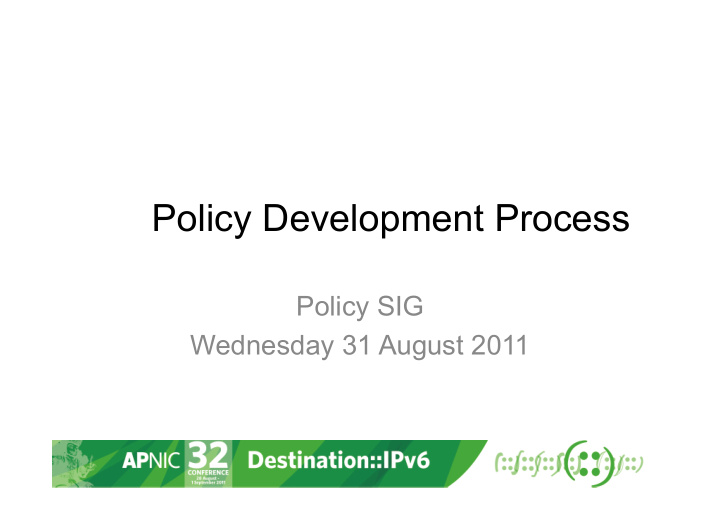



Policy Development Process Policy SIG Wednesday 31 August 2011
Policy SIG Charter Develop policies and procedures which relate to the management and use of Internet address resources by APNIC, NIRs and ISPs within the Asia Pacific region • Mailing lists sig-policy@apnic.net sig-policy-chair@apnic.net
Steps to Implementation • Proposal submission • Mailing list discussion before meeting • Consensus at Policy SIG Meeting • Consensus at the AMM • Comment Period to confirm consensus • EC endorsement • Editorial Comment period • Implementation
Consensus Decision Making • Consensus is described as “ general agreement ” • Chair “ takes into consideration ” comments on mailing list and at meeting • Show of hands is a way of “ broadly gauging opinion ” • Voting would disadvantage those not physically present
Consensus Used in PDP • Open (multi-stakeholder involvement) • Anyone can make proposals, discuss policies, and participate in decision making • Transparent (public and documented) • APNIC publicly documents all policy discussions and decisions • Bottom-up (community-driven) • The community drives policy development
Chair Responsibility at SIG meeting 1. Provide a neutral overview of all proposals. 2. Provide contextual presentation before groups of related presentations. 3. Control the time and order of speakers from the floor. 4. Confirm the intention of each intervention (supports, opposes, conditional support or opposition).
Remember • All proposals are submitted with good intentions • Opinions may differ... • …But we all want the same thing… • …A strong and healthy Internet • So please… • Be polite and professional • Respect other’s opinions • State name and affiliation • State whether you support or oppose
References • APNIC Policy Development Process • www.apnic.net/policy/policy-development • SIG Guidelines • www.apnic.net/sigs/sig-guidelines.pdf • Mailing list archive • mailman.apnic.net/mailing-lists/sig-policy • Mailing list subscription • mailman.apnic.net/mailman/listinfo/sig-policy
Objections • Minor Objections • some problems may occur for some members of the group • Major Objections • major problems will occur for parts of the community • Participants should “work together” to resolve
Recommend
More recommend